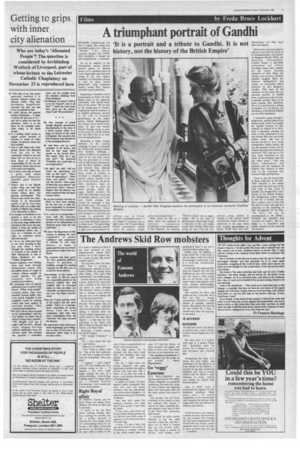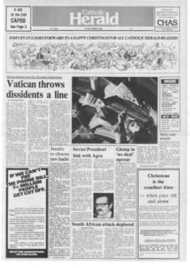Page 7, 17th December 1982
Page 7

Report an error
Noticed an error on this page?If you've noticed an error in this article please click here to report it.
Tags
Share
Related articles
Richard Attenborough's Quest For Mahatma Gandhi
Many-faceted Portrait Of A Great Man's Youth
Patience As A Viceregal Virtue
The Bishops Of Brailes
`hail Mary' On The Way Into Battle
A triumphant portrait of Gandhi
'It is a portrait and a tribute to Gandhi. It is not history, not the history of the British Empire'
RICHARD Attenborough has done it again. His twenty-year cherished project for a film on "Gandhi("A", Odeon, Leicester Square) has already been acclaimed — though not quite unanimously — a triumph.
So, as an addition to the international motion picture portrait gallery of national heroes, it is a polished piece of work, impeccable spectacle with acting of the very highest standard, an impressive picture to take its place beside Hollywood's long acclaimed biopics, beside Zola, Pasteur and other world celebrities.
Beginning at Gandhi's end by assassination at Delhi, the film flashes back in the approved convention, over known headlines of his career. We see him as the young man in London, studying law and the manners of an English gentleman, devoted to his wife (a beautiful performance by the Indian actress Rohini Hat-tangamdy) then doing a job in South Africa where he gets into trouble himself through trying to come to the rescue of a South African who has fallen foul of an early form of segregation law.
Returning to India. Gandhi embarks on his cunning campaign to press or persuade the British into leaving Indians their freedom. Although a variety of officers are played by some of our very best actors. they are presented as a brick wall of stiff-necked bureaucrats and the film's baddies, though only General Dyer (Edward Fox) who orders fire into the dense crowd of civilians at Amritsar is identified with a specific villainy. Gandhi is the hero of this portrait, and all the other characters must be subject to him to stress his heroic persona. About this stage, Gandhi assumes the white loin-cloth which used to be his familiar uniform even in the most formal settings, and extends his campaign to urge the British home. The names of John Mills (Viceroy) Trevor Howard (Judge Broomfield) and John Gielgud as Lord Irwin are enough to guarantee the standard of the acting, but there is very little individual character For them to act. The good Judge Broomfield, sentencing Gandhi :o eight years imprisonment for ;edition says in Trevor Howard's sympathetic tones: "I am obliged to sentence you to eight years, but if some future British government should reduce the sentence, nobody will be more pleased than I." What raises the film as a whole above the standard of classical commercial competence is the performance of Ben Kingsley, the National Theatre's player who is AngloIndian. His is the kind of performance which really brings a character to life, and makes people talk of living rather than acting the part, from the raw, nervous young student in London to the mature world revolutionary leader dressed or undressed to the part. Even such leading personalities as Jinnah, Pandit Neru and Lord Mountbatten are little more than stock figures.
Some of the American players sink as it were into the scene, to be inconspicuously well played. As Margaret Bourke-White, the American correspondent, Candice Bergen is splendidly professional and selfless; Geraldine James does wonders for the rather tiresome character of Miss Slade, the disciple who becomes Gandhi's adopted daughter Mira. All, however distinguished and stylish, are dominated, almost flattened by Ben Kingsley's Gandhi. That must be the intention, for the whole film is a partisan portrait of Gandhi from a particular point of view, a portrait perhaps likely to be more popular than beneficial. For it is a portrait and a tribute to Gandhi. It is not history, not the history of the British Empire or even of its liquidation.
I remember going through a progressive. pacifist phase in my distant youth. w hen I too caught the Gandhi doctrine of nonViolence as relayed to us here. And I remember pouring out some of that enthusiasm to my late brother Rob who was in the Indian Army. (He was to become the first C. in C. of the independent Indian Army). He was the gentlest of men, but he looked unusually stern before he answered "All I can say is I've seen more bloodshed in the name of non-violence than for any other cause". That was before independence and partition and the massacre of millions that followed in their wake in the communal riots between India and Pakistan.
There is only the merest hint of these outbreaks in the film. Their omission is the reason some doubt has been cast on the total truth of this vision of Gandhi. For though this is not a history of the British Empire, that background cannot really be left out or twisted. But the film's makers seem to have felt the need to cover this gap in a statement at the beginning of their propaganda for the film: "No man's life can be encompassed in one telling." Certainly not Gandhi's and certainly not India's. But as a biopic it is impressive and closely attuned to the mood of the moment.
blog comments powered by Disqus











